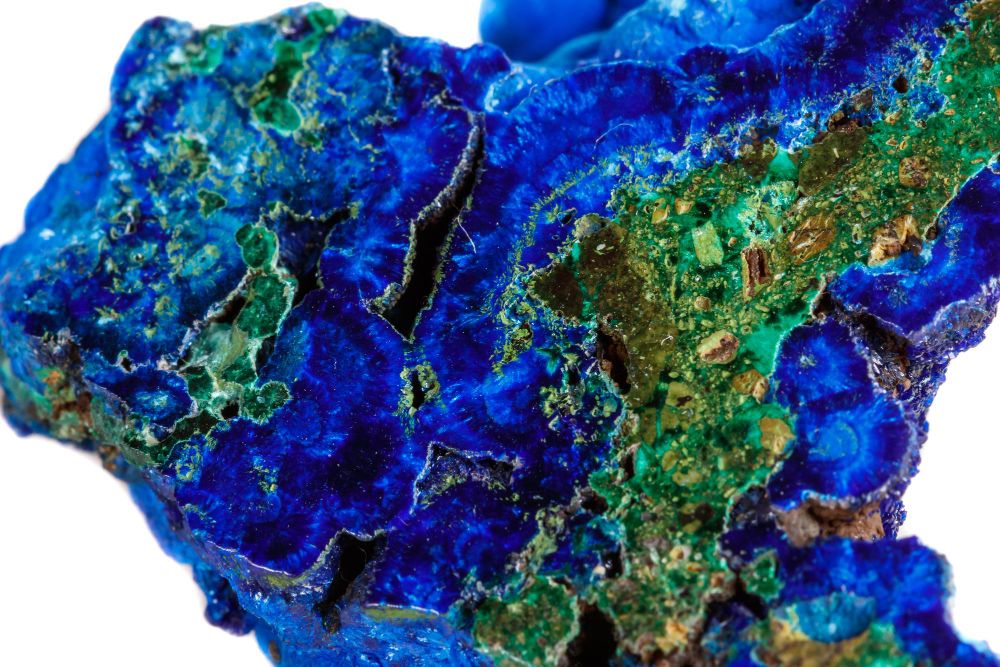Azurite is a vibrant, deep blue copper-based mineral with the chemical formula Cu₃(CO₃)₂(OH)₂. Its striking color and crystal structure have made it a prized gemstone and pigment for thousands of years. Azurite often forms through the oxidation of copper ores in regions with abundant copper deposits and is typically found in association with other copper minerals, especially malachite, with which it frequently occurs in blended specimens.


Physical Appearance and Crystal Structure
Azurite is renowned for its intense blue color, which can range from light to dark, often described as „azure” or „indigo blue.” The mineral crystallizes in the monoclinic system, typically forming prismatic crystals that are sharp and well-defined. Azurite crystals can appear in a variety of shapes, from small, elongated blades to blocky, cubic-like forms. The most desirable specimens are often those with well-formed crystals that are deep, vivid blue.
In addition to its crystal forms, azurite can occur in massive, nodular, or stalactitic habits, where it may take on a more earthy or granular appearance. When polished, it reveals a bright luster, ranging from vitreous (glassy) to sub-vitreous or even earthy in its massive forms. The surface of azurite can be smooth and reflective, making it especially valuable as a gemstone or ornamental stone.
Formation and Occurrence
Azurite forms in the oxidized zones of copper deposits, often in arid regions or areas with a significant amount of copper ore. As groundwater that contains dissolved carbon dioxide reacts with copper minerals, azurite precipitates out as a secondary mineral. Over time, azurite can slowly alter to malachite, another copper carbonate mineral that is green in color, due to further weathering and exposure to air and moisture.
Azurite is commonly found alongside malachite, cuprite, and chrysocolla, and it often forms beautiful, multicolored specimens that combine deep blue and vibrant green hues. Some of the most notable deposits of azurite come from regions such as Morocco, the southwestern United States (Arizona and New Mexico), Australia, France, and Mexico.
Varieties and Associations
Azurite frequently occurs with malachite, a green copper carbonate mineral that shares a similar chemical composition but differs in color due to its higher oxidation state. These two minerals can grow together, creating striking azurite-malachite specimens, where rich blue and green bands or patterns are visible. These specimens are highly prized for their visual appeal and are often used in decorative items and jewelry.
Azurite also occurs in a massive, less crystalline form known as blue carbonate. In these forms, it is more common as a mineral in copper deposits rather than as a gemstone. The transformation from azurite to malachite occurs through the gradual loss of water and oxidation, which is why some azurite specimens might show signs of green malachite developing on the surface.
Historical and Cultural Significance
Throughout history, azurite’s vivid blue color made it highly valuable as a pigment. In ancient Egypt, Greece, and later Europe during the Renaissance, artists used ground azurite to create blue paints for murals, frescoes, and religious icons. However, azurite was eventually replaced by ultramarine, a more stable pigment derived from lapis lazuli, as azurite tends to darken and turn green over time when exposed to air and moisture.
In addition to its use as a pigment, azurite has long been prized as an ornamental stone. Its vibrant color and unique patterns have made it popular for use in carvings, inlay work, and jewelry, especially when combined with malachite. Ancient civilizations, including the Chinese and Native Americans, valued azurite not only for its beauty but also for its supposed mystical properties. It was believed to enhance insight, intuition, and creativity.
Uses and Value
While azurite is relatively soft, with a Mohs hardness of 3.5 to 4, it is still widely used as a gemstone in jewelry. Its deep blue color, often accompanied by streaks of green malachite, makes it an eye-catching stone for pendants, beads, and cabochons. However, due to its softness and tendency to alter to malachite, it is often treated carefully in jewelry settings.
Azurite is also of interest to collectors due to the beautiful and often unique forms in which it can occur. High-quality azurite crystals, particularly those from famous mining localities like Morocco or Arizona, can fetch high prices in the mineral collecting world. Specimens showing the intricate mix of azurite and malachite are especially prized for their aesthetic value.


Alteration to Malachite
One of the unique aspects of azurite is its instability in open air. Over time, azurite can slowly alter to malachite, transitioning from blue to green. This happens when azurite is exposed to water and carbon dioxide, causing it to absorb additional oxygen and form the more stable malachite. This process often results in mineral specimens that show a beautiful combination of blue and green as the two minerals intertwine and grow together. The alteration process makes azurite less stable over long periods, particularly as a pigment, but this transformation adds a dynamic element to the mineral’s life cycle.
